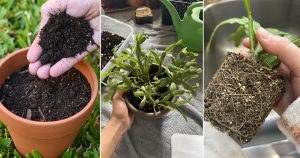Wondering When Are Sempervivums Dormant? Learn about it and keep your hens and chicks thriving in cold as well as warm climate!
Sempervivums are popular for their hardiness and can be settled in any condition. But did you know these resilient plants have a nap period? Find out when Hens and Chicks go dormant in every weather and it will help you keep them in tip-top shape all year round.
When Are Sempervivums Dormant?
As we already know that Sempervivums are tough succulents, but they have dormant periods that many gardeners may overlook. Even though they can handle a variety of climates, they have specific seasons when they slow down and take it easy.
Summer Dormancy in Hot Climates
If you live somewhere where the summer sun feels like it’s trying to cook everything, with temperatures often above 85°F (29°C), your Sempervivums might decide it’s time for a summer break. In hot regions like parts of the Southwest or Southern California, Hens and Chicks take a pause just to ignore heat.
When it gets really hot, you might notice them slowing down, and their leaves might even close up a bit. Interestingly, some Sempervivums might also enter a short rest period during the hottest part of the summer. But, it will start growing again when things cool down in September and October.
Winter Dormancy in Cold Climates
In colder areas, where winter temps drop below freezing (32°F or 0°C), Sempervivums go into winter dormancy. This is their way of surviving the cold. You might notice them hitting the pause button on growth and their colors fading to a dull or reddish tone.
Don’t worry—it’s totally normal. In fact, in really cold places where temperatures can drop as low as 20°F or (7°C) or even lower, your Sempervivums will settle in for a deep winter sleep.
Did you know that dormancy in Northern Hemisphere plants is because of chemical changes within plant cells, triggered by cooling temperatures and shorter days in late summer and fall. This process helps them survive by preventing water inside the cells from freezing. To “wake up” and break dormancy, plants need a cold period of about 2 months, at around 40°F or colder, before they can start growing again in warmer weather.
Growing Time in Mild Climates
Lucky you if you live somewhere with mild temperatures that hang between 40°F to 80°F or 4°C to 27°C most of the year! Your Sempervivums might not experience a significant dormancy. Instead, they might keep growing, just a bit more slowly.
These mild conditions are perfect for Sempervivums, allowing them to grow steadily without needing a big rest. You’ll likely see them staying active with lovely colors.
What Does Dormancy Mean for Care?

Knowing when your Sempervivums are resting helps you adjust how you care for them. During dormancy, whether in the winter or summer, they need less water. Overwatering during these periods can be the reason for root rot, a common issue for succulents.
So, focus on providing well-drained soil and avoid fertilizing until the growing season resumes. Plus, provide stable conditions. If it’s cool, keep them indoors in a bright and warm spot. If it’s hot, simply keep them in a cool shady area that gets some morning and evening sun.
When they wake up from dormancy, usually in spring or fall depending on where you live—you’ll see them perk up and show off with new growth and beautiful colors.
Wrapping up!
Understanding when your Sempervivums go dormant helps you care for them according to their natural rhythm. Have you noticed your Sempervivums taking a break? Share your experiences and tips in the comments below!







